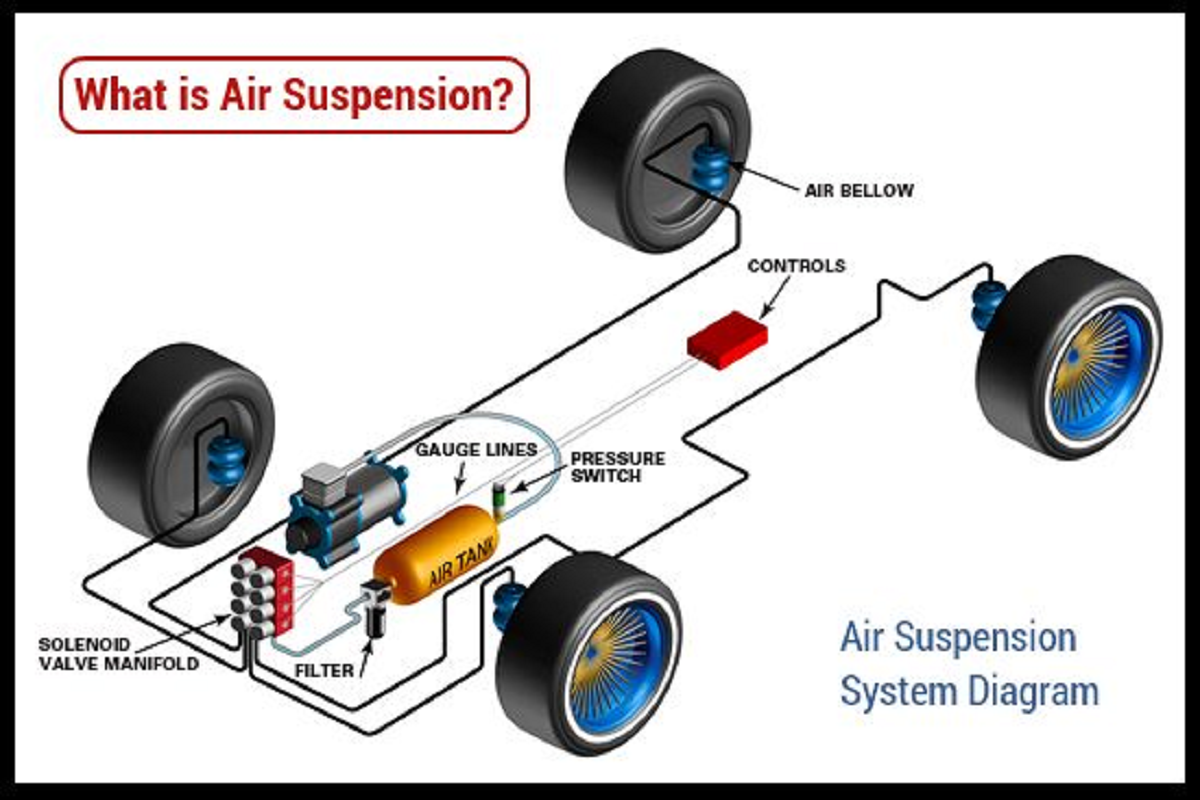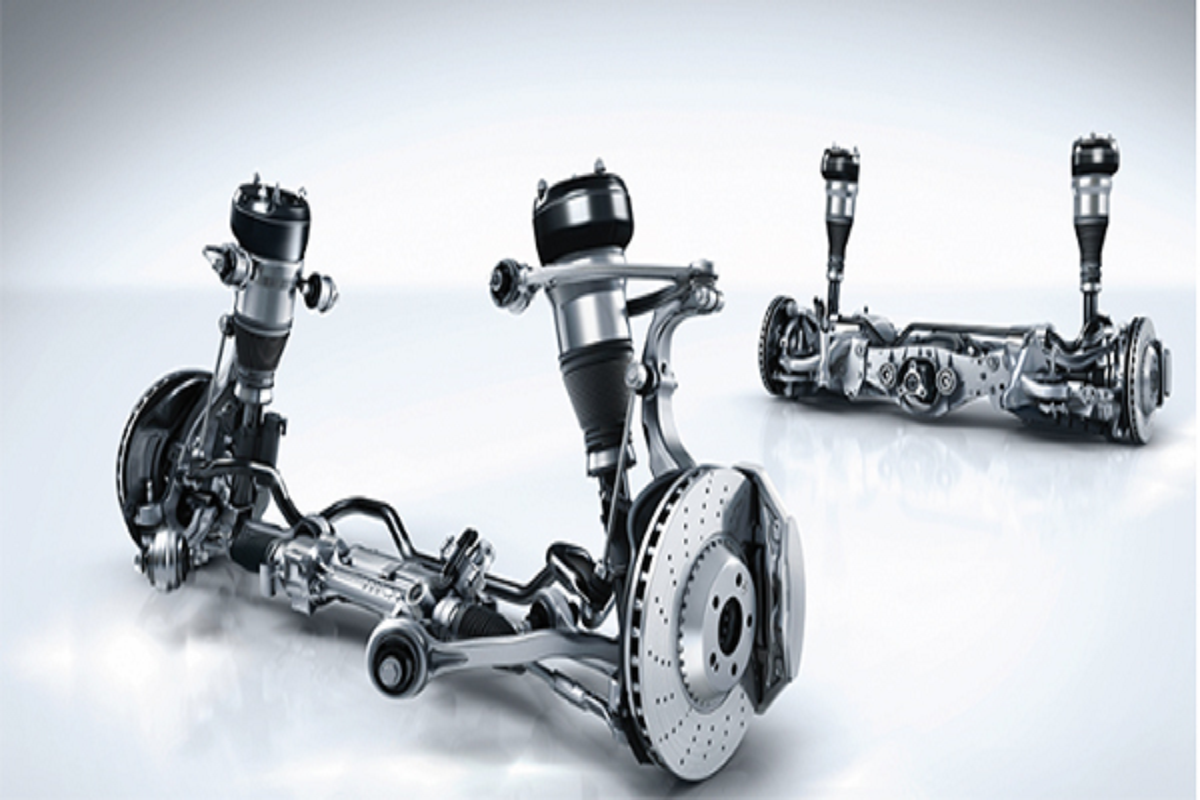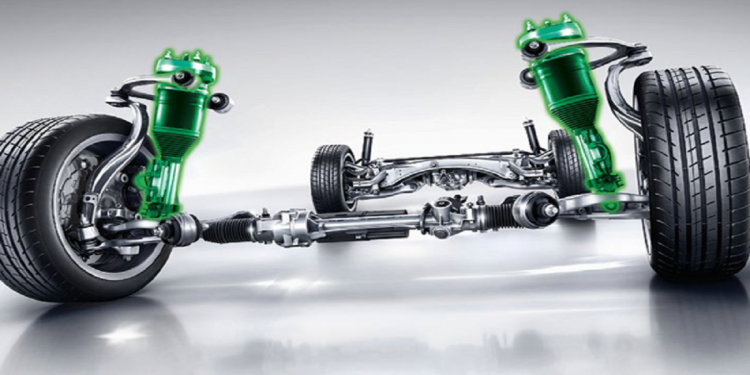If you are a driver who would love improved comfort behind the wheel then the air suspension system may be for you. The air suspension system provides a cushion between the vehicle body and wheel to reduce the vibration felt during travel by replacing the traditional spring suspension (replacing steel coil springs or leaf suspension) above the vehicle wheels with airbags made of rubber and polyurethane.
These airbags are inflated by an onboard air compressor or electric pump, to a certain pressure to behave like traditional springs. The air direction is controlled by air valves that let the air go into different parts of the system to inflate.
Visit Our Shop to Buy Air Suspension
The air suspension system has 7 components and these are;
- Air filter
- Air Accumulator
- Relief valve
- Air spring
- Lift control valve
- Return valve
- Supply line

Here’s How the Air Suspension System Work
The air compressor takes the atmospheric air through a filter and compresses it to a pressure of about 240 MPa, at which pressure the air in the accumulator tank is maintained, which is also provided with a safety relief valve. This high-pressure air goes through the lift control valve and the leveling valves, to the air springs. Each air spring is filled with compressed air which supports the weight of the vehicle. The air gets further compressed and absorbs the shock when the wheel encounters a bump on the road.
The Uses of Air Suspension
One of the popular use for air suspension is to keep the rear of your truck from squatting while towing or hauling. Trucks can be outfitted with air shocks in the rear to inflate when the truck has a heavy load. This helps to keep your truck level, reducing stress on components such as your driveshaft.
You can also use air suspension to raise/lower the vehicle for specific purposes. If you are needing adjustable suspension to clear obstacles or to allow for something to be loaded into your vehicle, an air suspension system could be a great addition to make life easy.
It also provides adjustable ride height and what this means is that the vehicle owner simply wants their vehicle to get to a certain stance, but does not want to drive at this height at all times. Air suspension makes this very easy due to its on-the-fly adjustability.
Top 5 Reasons to Run Air Suspension

Ride Quality
Air suspension setup allows for a better ride quality due to the design of the air shock compared to the shocks, struts, and coil springs. Air shocks make for comfortable and softer ride quality and this improved standard of ride comfort, noise, harshness, and vibration reduction attend with air springs reduces both driver and passenger fatigue.
One of the main benefits of air suspension cars is the improved comfort behind the wheel, making them good for daily driving. The adjustable air suspension makes for a more comfortable ride on poor-quality roads and can improve control when off-roading. The use of airbags above your wheels, rather than springs, also improves the quality of the journey for passengers. There is also less wear and tear on the suspension system and vehicle components, due to reduced harshness and vibration, particularly with heavy-duty driving. Air suspension compensates for potholes, uneven surfaces, and speed bumps in the road allowing your vehicle to glide easily over the road surface.
Versatility on Load and The Road
Another advantage of air suspension is its versatility on load and the road. The height of the car can be adjusted according to the load, the ‘kneel’ or ‘raise’ functions making loading easier from the outset. Air suspension gives consistency across all wheels, and there is a lower risk of body roll when turning corners, less risk of breakages, and less load shifting and damage caused due to reduced vibrations through the suspension. Plus, better control due to increased firmness provides improved towing capabilities for larger vehicles.
An air suspension system allows the driver to adjust the car to suit their personal preferences for ride comfort and handling. When the driver can choose between a harder drive for motorway driving or a softer feel for demanding roads, the driver maintains control no matter the terrain. Higher cornering speeds and greater levels of control when turning corners can be achieved with air suspension, as the vehicle is better suited to the conditions of the road. An adjustable suspension that can lower the vehicle to the ground means the drag can potentially reduce at higher speeds. Additionally, the ability to raise the car for everyday use is extremely handy for off-road driving.
Less Wear & Tear On Other Components
Using air suspension for your truck or trailer can help save some wear and tear on other components. When a truck is loaded down from hauling or towing, there can be stress on the u-joints and driveshaft due to the pinion angle shifting. With air shocks, you can load up your shocks with air and bring your truck back into a level position. Less wear and tear on the suspension system due to reduced harshness and vibration of heavy-duty driving. Trailers last longer with air suspension because the system components don’t take on as much vibration.
Fuel Economy
Vehicles with air suspension can be adjusted to road type, and so they benefit from better fuel economy. For example, a lower ride height for motorway driving means better aerodynamics and reduced wind resistance. Conversely, a suspension that is better suited to a particular road surface with better control can achieve higher corner speeds and lead to time-saving on routes with many turns.
Improved Ride Height
Since you can adjust your ride height, you can achieve the fitment you want with your wheel setup. Air suspension improves the ride height based on the load weight and a vehicle’s speed. This can be especially helpful if you don’t have a lot of experience dialing in your fitment. It is also way easier to achieve the fender-to-lip fitment without having to spend hours dialing it in.
Although they are quite expensive to install, their pros exceed their cons, an air spring system is a reliable feature that provides improved comfort and quality when driving, the ability to tackle any terrain, the ability to carry a variety of load weights, and potential for better fuel economy.




